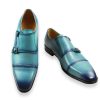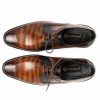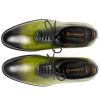Hand vs. Machine Lasting: Pros, Cons, and Techniques for Flawless FootwearIntroduction: The Foundation of Footwear
In footwear design, lasting is the transformative process where flat materials become three-dimensional structures. This complex marriage of art and engineering determines not just aesthetics but critical performance factors: comfort durability, waterproofing, and repairability. Unlike temporary adhesion methods, welted constructions create a renewable foundation—a philosophy central to sustainable footwear. As brands increasingly prioritize longevity over disposability, understanding these methods becomes essential for designers and consumers alike.
1. Lasting Fundamentals: Anatomy of a Transformation
The Last’s Role: A last (traditionally wood, now often plastic) serves as the mold defining volume, toe shape, and heel height. During lasting, the moistened leather upper is stretched and secured to this form, creating the shoe’s fundamental architecture.
Critical Sub-Processes:
- Inseaming: Attaching the upper to the insole via a welt using precision stitching.
- Outsole Attachment: The welt provides an anchor point for stitching the outsole.
- Cork Filling: Filled cavity molds to the wearer’s foot over 30-40 wears.
Design Insight: Last shape directly impacts biomechanics and manufacturing complexity.
2. Goodyear Welt: Industrial Precision Meets Heritage
History & Mechanics: Patented in 1869, this machine-driven method revolutionized footwear. A canvas rib is cemented to the insole. The upper and welt are then machine-stitched to this rib.
Performance Tradeoffs:
- ✅ Pros: High water resistance; easier resoling
- ❌ Cons: Stiff initial feel; cork compaction risks
| Factor | Goodyear Welt | Hand Welt |
|---|---|---|
| Construction Time | 5-10 mins (machine) | 2-5 hours (hand) |
| Insole Thickness | 3-4mm | 5-8mm |
| Resole Limit | 3-7 times | 10+ times |
3. Hand Welting: Craftsmanship as Engineering
Process Nuances: Artisans cut a shallow channel into a thick leather insole. Using awls and needles, they create a lockstitch that won’t unravel.
Why Designers Choose It:
- Superior arch support that molds intimately
- Absence of gemming allows natural flexing
- Hand-stitched channels enable decades of use
4. Alternative Methods: Beyond the Welt
a) Blake Stitch: Sleekness Over Substance
Mechanics: Single stitch through outsole, insole, and upper.
b) Norwegian Welt: Extreme Weather Armor
Mechanics: Upper turned outward before being sandwiched between welt and midsole.
c) Cemented & Strobel: The Fast Fashion Standard
Reality: Dominates entry-level footwear with zero resole capability.
5. Tiered Quality Spectrum: From Entry to Endgame
| Tier | Price Range | Construction |
|---|---|---|
| Entry | <$350 | GY w/ fiberglass shank |
| Mid-Level | $350-$750 | GY/Norwegian |
| End-Level | $750-$5000+ | Handwelted/bespoke |
6. The Sustainable Edge: Why Welting Wins Future
- Circular Design: Resoling reduces waste by 75% vs cemented footwear
- Material Innovation: Recycled rubber + cork blends
- Consumer Shift: 42% under-35s prefer repairable premium goods
Conclusion: Selecting Your Construction Compass
Match the method to the mission: Hand welting for bespoke refinement, Blake for fashion-focused designs. Consumers should invest tier-wise based on commitment to craftsmanship.












